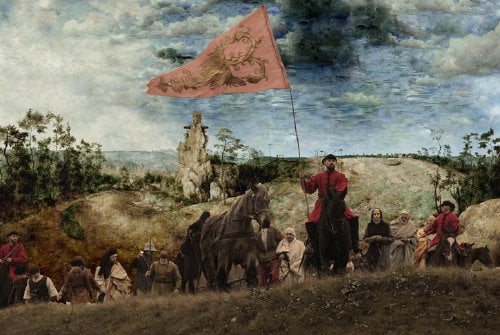The Mill and the Cross

What if you could enter a painting. Polish director Lech Majewski casts Rutger Hauer ("Hobo with a Shotgun") as painter Pieter Bruegel the Elder to guide us through his 1564 painting The Way to Calvary in "The Mill and the Cross."
Laura's Review: B
Filmmaker Lech Majewski uses today's technology to bring his audience into the past. Using the analytical book by Michael Francis Gibson, the filmmaker follows twelve of the painting's hundreds of people to impart a historical understanding of how Bruegel condemned Spain's religious persecution in his native Holland by making his Christ contemporary. Along the way he also gives us insights anthropological and artistic. Bruegel himself shows us his early sketches to help us see how he constructed his artwork, from its center like the web of a spider to its balanced circles of life and death. Majewski shows the painter as the father of six by a younger, lusty wife and the kids provide a lot of humor. Outside their door we can see the painting's mill from a different perspective than the painting. Outside the painting, there is also Nicholas Jonghelinck (Michael York, "Cabaret"), an Antwerp banker and art collector who has Bruegel's The Tower of Babel and The Hunters in the Snow hung on his wall. He asks questions of Bruegel for the audience when he's not railing at the Spanish from his window. A subject of the painting, Charlotte Rampling ("Life During Wartime," "Melancholia") is Bruegel's Virgin Mary, speaking of how the crowd turned on her son (and we learn from the artist her connection to his own The Adoration of the Magi). Other characters in the painting don't have discernible dialogue, but ebb and swell with an almost comical babble. Majewski not only found locations that resemble the painting's landscape, but constructed matte backdrops with which to layer in his characters. Sometimes we follow conventional action within the paintings' characters' homes and along the way to their place in the painting. At others Majewski uses a combination of blue screen, location and digital manipulation, achieving a 3D effect that puts us within Bruegel's work (one is reminded of that Nazi war criminal who wished himself into what, in the dark, he thought was the peaceful painting he so admired in the old 'Night Galleries' series). Most interesting of all is Bruegel's explanation of his art of misdirection. Here was an artist who understood how the most significant of events can be overlooked - the filmmaker parallels his subject with a brief 'next day' coda. The film ends with a zoom out and away from The Road to Cavalry from where it hangs on a wall of the Kunsthistorisches Museum in Vienna. Majewski's film is painterly in its own right, but so celebrates another's work of art it should inspire museum visits.
Robin's Review: DNS
DNS

